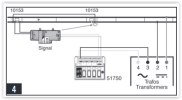I'm planning a layout for the last Kirkbean Playmobil Exhibition including two passing loops on an oval, at any one time, one oval will have a train parked on it and the other will be empty while its train circulates the oval. The idea is that a train will run clockwise for a while and then be parked on the empty passing loop and the other train will then be released from its passing loop and circulate anti-clockwise, being returned to it after a few circuits and so on.
Clearly, the passing loops need to be isolated and I originally thought of doing so through the points at each end of the passing loops. However, it occurred to me that if there were an isolating point at the entry end of each passing loop and an LGB semaphore signal US style at the exit end of each loop, I could isolate the loops that way and release the trains under signals.
Is my thinking correct on this, please?
Clearly, the passing loops need to be isolated and I originally thought of doing so through the points at each end of the passing loops. However, it occurred to me that if there were an isolating point at the entry end of each passing loop and an LGB semaphore signal US style at the exit end of each loop, I could isolate the loops that way and release the trains under signals.
Is my thinking correct on this, please?
-
2
- Show all





